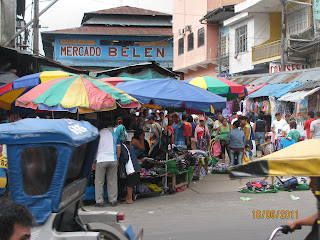Iquitos
I’d always assumed if you couldn’t access a city by road, it must be a backwater. How wrong I was. The Peruvian town of Iquitos

Cargo boats call in at Iquitos
We were warned numerous times about safety and theft when we visited the colourful community of Belen, but we did not find it to be overly dodgy – having said that I wouldn’t go there alone or at night. The market was full of life when we visited in the morning, with rows upon rows of stalls piled high with glossy fresh fish that looked as if it had just been hauled out of the river. We spotted piranhas and several interesting varieties of catfish.
Meat sections at markets are always entertaining and this one did not disappoint. There were all manner of animals, including your standard cows, chicken and pigs, resplendently displayed with all of their entrails intact were visible. Some of the more exotic options included splayed jungle rats, guinea pigs and regrettably, river turtles and terrapins. Someone obviously forgot to tell these guys about endangered species.
 |
| butterflied jungle rat...anyone? |
The hustle and bustle continued down the hill to the river bank, the height of which changes constantly. Amazonians live by two things – the ubiquitous rain, which comes night or day at any time of the year, and water level of their river, which varies dramatically from month to month.
Close to the water’s edge, the streets were lined with mud, muck and huge piles of rubbish. Just one month ago, the entire area had been under water, and the level had only recently receded. For over half of the year, a good part of Belen is submerged. Streets become canals. People abandon the bottom story of their homes and shops which are instead used to store the canoes required to get from place to place.
Some years the water gets so high it starts to flood the top stories of peoples’ rickety wooden homes, and creeps further uphill to where it is not expected. When the water recedes (usually in April or May each year), the cleanup begins, including construction and repair work for parts of properties damaged when they are under water.
 |
| Floating houses..with floating outhouses |
Many families don’t bother with precarious stilt houses and instead have built floating dwellings that rise and fall with the water level. There are around 15,000 people living in Belen, and nearly half live in the lower area that is flooded annually, either in stilt or floating houses. A whole industry has sprung out of the floating houses, including floating petrol stations with bowser pumps, floating grocery shops, restaurants and even a couple of bars.
We jumped in a small motorized canoe and zoomed in and out of these floating houses, many joined together to form streets. Nearly all of them have electricity, but obviously plumbing is out of the question! Many people even had chickens pecking around on the wooden rafts that the simple two-roomed shacks are built on. Our guide, a Belen local, said up to three families live in each house.
Running with the quirky vibe of the town is a weird and wonderful collection of expats. Our hostel is called “Hobo hideout” which made absolutely no sense to us until we found out that the owner is an Alaskan, and a hunting enthusiast. The lobby area has a slightly macabre collection of taxidermy, including a stuffed grizzly bear, several jungle animals and even a human skull stolen by the owner from an ancient Incan burial site.
Another American expat is on the run from the authorities in several countries for conning other tourists, pretending to be a guide and then robbing them, and also on some serious sexual assault charges. We discovered this when we ran into a fellow Australian in one of the bars, who had been ripped off by the guy and has now spent several months trying to pursue him.
You need to keep your wits about you here, and not just on account of the kooky expats. Just about everyone here is trying to sell you some kind of tour or experience in the jungle. From the moment we were mobbed by motor taxi drivers when we arrived on the boat, to the people in our hostel, to random guys following you up and down the street with colourful brochures, you’re a sales target.
 |
| pirañas! |
Fortunately though, our instincts did not let us down. It is far cheaper to take tours further into the Amazon jungle than in the Colombian town of Leticia
In the end we booked a four-day tour with a guide that was working at our hostel. Our guide - Mogli the Kid - was born and bred in the jungle, he is from a village a two-day boat ride away from Iquitos, and has led many groups of scientists, documentary makers and other jungle-obsessed nitwits up some of the smaller tributaries of the Amazon only accessible by dugout canoe.
Stay tuned for the next instalment in our Amazonian adventure!


No comments:
Post a Comment